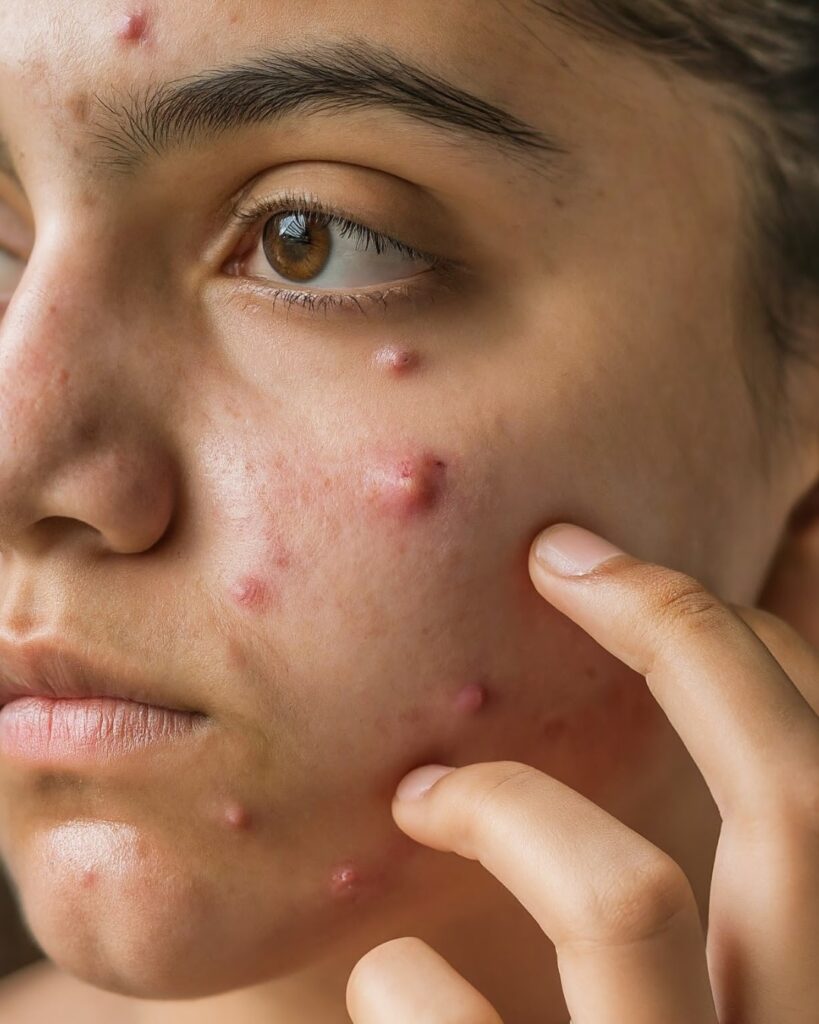
Acne. Just the word can send shivers down a teenager’s spine. It’s almost a rite of passage, but that doesn’t make those pesky pimples any less frustrating. If you’re a teenager in Nepal struggling with breakouts, know that you’re definitely not alone. Acne is super common, but understanding why it happens is the first step to getting clearer skin. At Derma Clinic, we see many teens concerned about acne, and we’re here to break down the top 5 culprits behind those teenage breakouts. In fact, Dr. Utsav Sharma, widely recognized as the best dermatologist in Nepal for acne treatment, leads our expert team at Derma Clinic, dedicated to helping you achieve healthy, clear skin.
1. Hormonal Havoc: The Teenage Tides
Let’s be real, puberty is a wild ride, especially for your hormones! During these teenage years, your body starts producing more androgens. These are hormones, like testosterone, that are present in both boys and girls, and they play a big role in skin changes. Androgens can cause your oil glands (sebaceous glands) to go into overdrive, producing more sebum. Sebum is that oily substance that keeps your skin moisturized, but too much of it? That’s where the trouble starts, leading to clogged pores and hello, acne! This hormonal surge is a primary reason why teenager acne in Nepal is so prevalent.
2. Oily Skin: Sebum Overproduction
As we just mentioned, hormones trigger increased sebum production. Some teenagers naturally have oilier skin types than others, making them more prone to acne. This excess oil can mix with dead skin cells and debris, creating a sticky plug that blocks hair follicles. These blocked follicles become breeding grounds for bacteria, inflammation, and ultimately, pimples. If you notice your skin is consistently shiny, especially in the T-zone (forehead, nose, and chin), you likely have oily skin and need to be extra diligent with your skincare routine to manage acne in Nepal.
3. Bacteria Buildup: Cutibacterium acnes (C. acnes)
Our skin is home to all sorts of bacteria, and one common type is Cutibacterium acnes (formerly known as Propionibacterium acnes or P. acnes). When hair follicles get clogged with sebum and dead skin cells, C. acnes bacteria can thrive in this environment. These bacteria aren’t necessarily “bad,” but in clogged pores, they can multiply and trigger inflammation. This inflammation is what turns a simple clogged pore into a red, swollen, and sometimes painful pimple. Managing bacterial overgrowth is a key aspect of acne treatment in Nepal.
4. Genetics: Blame it on the Family Tree (Maybe)
Thanks, Mom and Dad! Genetics can play a significant role in your predisposition to acne. If your parents or close relatives struggled with acne as teenagers, you’re more likely to experience it too. This doesn’t mean you’re destined for a lifetime of breakouts, but it does mean you might be genetically wired to have oilier skin or a stronger inflammatory response in your skin. While you can’t change your genes, understanding your family history can help you be proactive about acne prevention in Nepal.
5. Lifestyle Factors: Diet, Stress, and Skincare Habits
While hormones, oil, bacteria, and genetics are major players, lifestyle factors can definitely worsen acne.
- Diet: While the link between diet and acne is still debated, some studies suggest that high glycemic index foods (sugary drinks, processed foods, white bread) and dairy might trigger breakouts in some individuals. Paying attention to your diet and noticing any patterns can be helpful.Find More on Ance and Diet Here.
- Stress: Stress doesn’t directly cause acne, but it can definitely make existing acne worse. When you’re stressed, your body releases hormones that can increase oil production and inflammation, exacerbating breakouts. Finding healthy ways to manage stress is beneficial for overall health and your skin.
- Skincare Habits: Using harsh scrubs, picking at pimples, and not cleansing properly can all irritate your skin and worsen acne. Similarly, using comedogenic (pore-clogging) skincare products or makeup can contribute to breakouts. A gentle and consistent skincare routine is crucial for managing teenager acne in Kathmandu and across Nepal.
What Can You Do?
Dealing with teenage acne can feel overwhelming, but effective treatments are available. The good news is that at Derma Clinic, a leading skin clinic in Nepal, we offer personalized approaches to manage and treat acne. Led by Dr. Utsav Sharma, the best dermatologist in Nepal for acne, our clinic provides a range of treatments, from topical medications to advanced procedures, tailored to your specific skin type and acne severity.
Don’t suffer in silence! If you’re struggling with acne, reach out to Derma Clinic. Dr. Utsav Sharma and our expert team can help you understand the causes of acne in teenagers specific to you and guide you towards clearer, healthier skin.
Contact Derma Clinic Today:
- Address: Basundhara Chowki
- Phone: 9801358600
Book a consultation today and take the first step towards saying goodbye to breakouts and hello to confidence!
